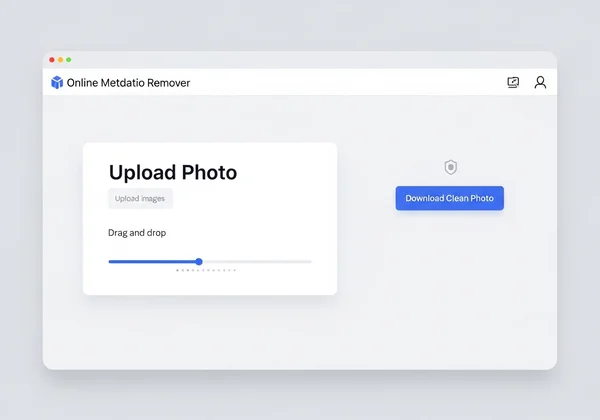Photo Metadata & EXIF Data: How a Metadata Remover Protects Your Privacy
Ever shared a photo online and wondered if you're giving away more than just the image? This guide reveals the hidden data embedded in your pictures – known as photo metadata, particularly EXIF data – and why understanding it is crucial for protecting your digital privacy. What can metadata reveal about you? Learn what secrets your photos might be revealing and how to easily take control with a simple online metadata remover.
What is Photo Metadata & EXIF Data Exactly?
When you take a picture with your smartphone or digital camera, it does more than just capture light and color. It also embeds a wealth of information directly into the image file itself. This invisible layer of data is known as photo metadata. It's like a digital fingerprint, providing context about how, when, and where the photo was taken.

The Basics: What is Metadata in a Photo?
In its broadest sense, metadata in a photo is "data about data." It’s structured information that describes, explains, locates, or otherwise makes it easier to retrieve, use, or manage an information resource. For images, this can include anything from the date and time of capture to copyright information and keywords for easy searching. It's automatically generated by your device, often without your direct knowledge or consent.
Diving Deeper: Understanding EXIF Data in Images
One of the most common and often overlooked types of photo metadata is EXIF data explained. EXIF stands for Exchangeable Image File Format. It’s a standard for the interchange of image files with digital cameras and scanners. EXIF data is embedded directly into common image formats like JPEG, TIFF, and HEIC. This technical information captures specifics about the camera, lens, and shooting conditions, but it also often includes details that can compromise your privacy.
What Can Hidden Photo Information Reveal About You?
The hidden photo information tucked away in your images can reveal surprisingly sensitive details, much more than you might realize. Understanding these potential exposures is the first step in mastering your image privacy.
Your Location: GPS Data & Where Your Photos Were Taken
Perhaps the most alarming piece of metadata is GPS data. Many modern devices, especially smartphones, automatically embed the precise geographical coordinates of where the photo was taken. This means anyone with access to the image file can pinpoint the exact location – your home, workplace, children's school, or vacation spot. This location data is a significant concern for personal safety and can be exploited by malicious actors.

Device Details & Technical Insights: Camera Model, Settings, & More
Beyond location, EXIF data includes technical specifics about the capturing device. This can range from the exact camera model and serial number to detailed camera settings like aperture, shutter speed, ISO, and focal length. It might even include the lens used. For professional photographers, this device information can be valuable for workflow, but for casual sharers, it’s just another piece of your digital profile you might prefer to keep private.
Timestamps & Personal Habits: When & How You Share
Every photo also carries a timestamp indicating when it was created, and sometimes even when it was last modified. These timestamps can reveal patterns in your life, such as when you're typically home, when you're away, or your daily routines. Combined with other data, this seemingly innocuous information can build a surprisingly detailed picture of your personal habits and schedules.
Why Removing Image Metadata is Crucial for Privacy
Given the breadth of information that can be stored, why remove metadata from images is a question with significant answers. It's not just about technical tidiness; it's about active steps in digital self-defense and compliance. Protecting your online presence often starts with controlling the information you unintentionally share.
Protecting Personal Safety & Property
Leaving GPS data in your photos can expose your physical location to strangers. Imagine sharing a picture from your home, only for it to reveal your exact address. This poses a direct threat to personal safety and the security of your property. By stripping this data, you add a vital layer of protection against potential stalking, burglary, or other privacy invasions.

Safeguarding Sensitive Information & Compliance
For professionals and businesses, unscrubbed metadata can lead to serious breaches of sensitive information. A company sharing marketing photos might inadvertently expose internal network details, employee locations, or even client data. Adhering to data privacy regulations like GDPR often requires meticulous control over what information is shared. Removing metadata helps ensure compliance and mitigates legal risks.
Maintaining Control Over Your Digital Footprint
In an age where our digital lives are constantly scrutinized, maintaining control over your digital footprint is paramount. Every piece of data you share contributes to this footprint. By proactively engaging in photo metadata removal, you decide what information about yourself, your habits, and your location is accessible to others. It’s an empowering step towards greater digital autonomy.
How to Easily Protect Your Photos Before Sharing Online
Recognizing the risks is important, but taking action is crucial. Fortunately, protecting your photos by removing their hidden metadata doesn't have to be complicated. There are a few options, but one stands out for its simplicity and effectiveness.
Manual Options: What Your Device Might Offer
Some devices or software offer rudimentary options to manage or clear certain types of metadata. For instance, on an iPhone, you can sometimes turn off location services for the camera or remove location data before sharing. Desktop software like Photoshop also allows for editing metadata. However, these methods can be clunky, time-consuming, and often don't remove all embedded data. They also require specific technical know-how, making them less accessible for the average user.
The Simple Solution: Using an Online Metadata Remover
For most users, the easiest, fastest, and most secure method to clear metadata is an online metadata remover. Tools like an online metadata remover provide a seamless, user-friendly experience designed for instant results. You simply upload your image, the tool automatically strips away all sensitive metadata like EXIF and GPS data, and you can instantly download your "clean" photo. It's a free, no-registration service that prioritizes your privacy by not storing any of your uploaded images. This makes it an ideal meta cleaner for quickly processing photos before sharing them on social media, with clients, or anywhere online. Experience how effortless it is to protect your privacy today.

Take Control of Your Image Privacy
Understanding photo metadata is the first step towards better digital privacy. By being aware of the hidden information in your images and using simple tools like our easy-to-use service, you can ensure your shared memories protect your personal information. Don't let your photos reveal more than you intend. Take control of your image privacy today and remove metadata with ease.
Frequently Asked Questions About Photo Metadata & Privacy
What is metadata in a photo, really?
Metadata in a photo is data embedded within the image file itself that provides information about the picture. This includes details like the date and time it was taken, the device used (camera model), and often, sensitive information like GPS coordinates of the location. It's essentially hidden data that travels with your image.
Why should I bother to remove metadata from images?
You should remove metadata from images primarily to protect your privacy and security. Hidden metadata can reveal your precise location, the exact time you were at a certain place, or details about your personal devices. Removing it prevents unintended disclosure of sensitive personal information to anyone who might view or download your photos, enhancing your photo privacy removal efforts.
Can metadata reveal my exact location?
Yes, absolutely. If your camera or smartphone has GPS enabled, it often embeds GPS data directly into the photo's EXIF metadata. This means anyone can use readily available tools to extract your exact geographical coordinates, potentially revealing your home address, workplace, or any other location where you've taken and shared a picture.
Is it safe to remove metadata using an online tool?
When choosing an online metadata remover free, safety is paramount. Reputable online metadata removers prioritize user privacy by processing images directly in your browser or on their servers temporarily before immediately deleting them, ensuring your photos are never stored. This approach offers a highly secure way to strip exif data without risking your original files or personal data.
Do all photos contain EXIF data?
Most digital photos taken with cameras, smartphones, or other image-capturing devices contain EXIF data. This includes popular formats like JPEG and TIFF. However, some image formats (like GIF or PNG in their simplest forms) contain less or no EXIF data, and images that have been heavily processed or re-saved multiple times might have some metadata stripped away. For complete peace of mind, it's always best to check and clear metadata from any photo you plan to share publicly.